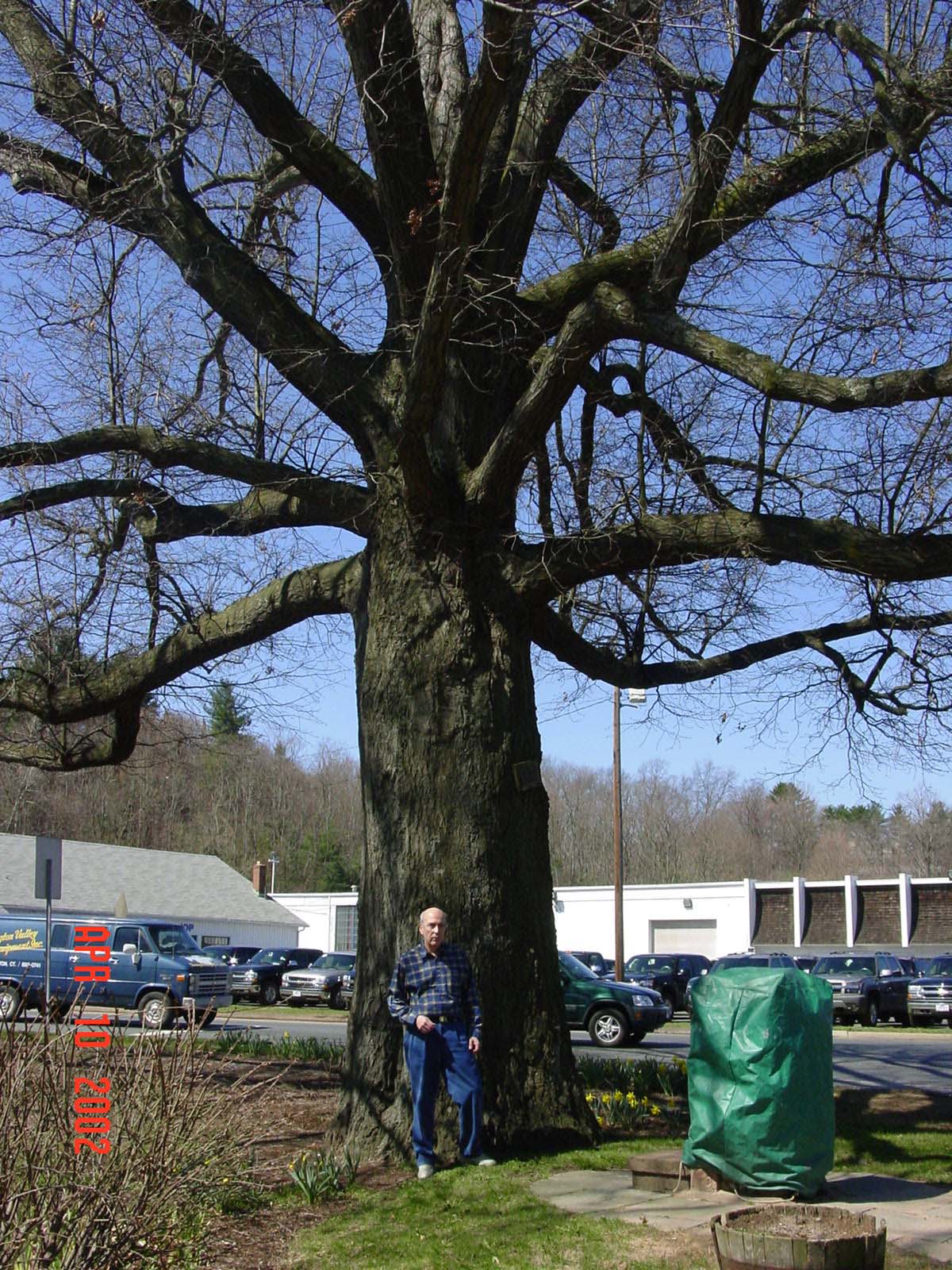|
By Glenn D. Dreyer
In 1902 Connecticut held a convention in Hartford to consider updating
our State Constitution. Delegates from all 168 towns attended and
worked on the document, which was apparently soundly defeated by a
subsequent statewide vote (Zaiman 1965). Joseph R. Hawley, one of
Connecticut's US Senators, arranged for the US Department of
Agriculture's Bureau of Plant Industry to provide Pin Oak (Quercus
palustris) seedlings, which he distributed to each of the 168
participants at the close of the Convention to commemorate the
experience. The delegates took the little trees back home, where they
were planted on town greens, school yards, church yards and, in many
cases, on the delegate's own property. Since there is still some
confusion, it should be noted that these trees have no relationship to
the Charter Oak (a White Oak, Quercus alba), offspring of which have
also been used for commemorative purposes. No information regarding the
parentage of these Pin Oaks has yet been found.
Realizing that the surviving 1902 Constitution Convention Pin
Oaks were 100 years old in 2002, I decided to resurvey the trees. The
Connecticut Notable Trees Committee had tracked these Oaks once before,
in 1986, when volunteers photographed and measured the circumference of
many of the trees (Dreyer 1998). Both of these projects were made
easier by the systematic efforts of Allen B. Cook, State Shade Tree
Inspector and Tree Warden Supervisor, who researched the Constitution
Pin Oaks between 1936 and 1938 (Cook 1941). Cook's report gives each
tree's circumference at 4.5 ft, the height, the average branch spread,
a condition rating, as well as the location of all 110 trees that he
found. Thanks to Cooks work and that of our committee, I believe the
Constitution Pin Oaks can be considered some of the most significant
and best-documented historic trees in the country. It does seem a bit
ironic, however, that trees planted to commemorate a political event
have become, due to their documentation and survival, more significant
than the event itself.
During 2002, 74 surviving Constitution Pin Oaks
were located
and documented with the following information: ownership, street
address and map, circumference at 4.5 ft above ground, average branch
spread, height, comments on condition; most were photographed. Ed
Richardson, volunteer with the Notable Trees Committee, located and
documented the trees of Hartford and Tolland counties; I personally
visited those in the rest of the state. These records have become a
permanent part of the Connecticut Notable Trees Archive housed at the
Connecticut College Arboretum in New London.
Even though many of the trees were surveyed 15 years ago, the
location descriptions were not updated at that time. Apparently there
wasn't much need for street addresses in the early part of the last
century, so in a number of cases we were dealing with locations like
"50 feet east of delegate So-and-So's barn." Sometimes it took a while
to figure out where the delegate lived in 1902. Other descriptions
still worked fine 60 years after Cook wrote them, for example the East
Haven tree was easy to find "on the Green in the center of town about
sixty feet north from the memorial cannon." We found at least one tree
that Allen Cook hadn't been able to locate (in Granby), a few not found
by the 1986 volunteers, and a few wrong trees measured in 1986, with
the correct individuals relocated in 2002. Less than 20 of these trees
had markers to indicate that they had any special significance.
As in Cook's day, the Marlborough Constitution Pin Oak tree is
still the smallest of the cohort, measuring 1-foot trunk circumference
in 1937, and only 4 feet 6 inches today. It is still being suppressed
by the two larger Sugar Maple (Acer saccharum) trees mentioned in
Cook's report. In 1937, the largest was in Windsor Locks, with a girth
of 7 feet 9 inches, but this tree was reported dead by 1985. In 2002,
the largest was in Avon at 14 feet 6 inches in circumference. This tree
is the only Constitution Pin Oak that I know of that had a 100th
birthday party in 2002, complete with a new plaque on the tree. Some
additional data on the 1902 Constitution Convention Pin Oaks are
provided in the accompanying table.
When checking out a particularly large tree, most people first
tend to wonder about its age. Usually this is not nearly as easy to
figure out as the size. If trees of a given species all grew at the
same rate, it would be fairly easy to accurately estimate the age by
measuring it. As can be seen from the table, a group of 74,
100-year-old Pin Oak trees growing in the small state of Connecticut
vary greatly in all dimensions. Thus it seems that trying to estimate
the age of a trees by it's size is likely to be inaccurate. However,
one can say with some certainty that the average 100-year-old Pin Oak
will be about 10 feet in circumference.
As far as I know, this is a unique data set; it is very
unusual to have good documentation of planting dates for trees this
old. I will provide location descriptions and full measurements for
each tree on the Notable Trees Website
(), and also hope to provide local
historic and conservation organizations with specific information about
their town tree.

| 1902 Constitution Pin Oak Tree Summary |
|
1937 (35 years old) |
2002 (100 years old) |
| Circumference range |
1 ft – 7 ft 9in |
4 ft 6 in – 14 ft 6 in |
| Circumference average |
4 ft 6 in |
9 ft 10 in |
| |
|
|
| Height range |
15 ft – 80 ft |
48 ft – 115 ft |
| Height average |
55 ft |
82 ft |
| |
|
|
| Branch spread range |
13 ft – 54 ft |
27 ft – 88 ft |
| Branch spread average |
40 ft |
63 ft |
| |
|
|
| Total documented alive: |
1902 |
168 |
| |
1937 |
110 |
| |
1986 |
86 |
| |
2002 |
74 |
References
Cook, Allen B. 1941. The Connecticut Constitution Oaks: Notes
by Alan B. Cook. Connecticut State Archives, call no. 342.74,
C762,1902oa.
Dreyer, Glenn D. 1998. Connecticut's Notable Trees (Second
Revision). Covered Bridge Press. North Attleborough, MA.
Zaiman, Jack 1965. The Needle's Eye: An Oak Story. The
Hartford Courant. July 25, 1965. Page?
This report was published in the Newsletter of the Connecticut
Botanical Society in 2002 and the Connecticut Urban Forest Council
Newsletter in 2003.
|









